Nyinkka Nyunyu is an Aboriginal sacred
site in
Warumungu country.
By chance the town of Tennant Creek grew up around
the home of the spiky tailed goanna, the Nyinkka,
a powerful Wirnkarra or ancestral being.
Right beside the Stuart Highway as it passes through Tennant Creek
are the rocks which are home to the Nyinkka.
The Nyinkka Nyunyu Centre is a Julalikari Council Aboriginal Corporation
community development project on behalf of the principal custodians
of the site and the Aboriginal community of Tennant Creek and the Barkly
region. It will be an archive centre for Aboriginal people where all
visitors will be welcome.
Stage 1, under construction, is a café and arid zone garden with
two traditional dance rings, for men and women's performances.
The landscaping shows different habitats of the Barkly region: spinifex
and snappy gum country through which the Nyinkka travelled, a river
feature marked by river red gums, and watercourse country around the
men's dance area.
The gardens will feature bush tucker and medicinal plants. All signs
including plant identification will be in Warumungu and English. Interpretive
material will explain the sacred site and different landscaping features.
A story path of sound poles will delight the visitor with sounds of
birds and animals from different habitats, children laughing and talking
in Warumungu, and other sounds which might be heard around any Warumungu
campsite.
A small shop is to be set up next to the café, to showcase the
work of local artists and direct visitors to Aboriginal galleries and
workshops in town.
This will be an active meeting place for local Aboriginal people but
visitors are also welcome. Regional tourism information, toilets and
cold water will be available.
Stage 2 is a major building housing a gallery, interpretive display
and shop.
The gallery will show occasional or long term exhibitions, including
material on loan from the South Australia Museum and Museum Victoria.
It will have museum standard lighting and temperature and humidity controls.
The second major building will also contain administration, a resource
area for further research, meeting room and staff kitchen and toilet
facilities.
The fixed interpretive display housed next to the gallery will be 'big
picture' visual statements about key Warumungu concepts, social system
and history including:
o People - family, appropriate behaviour
o Wirnkarra - law, religion
o Land, land ownership, the Warumungu land claim
o Time - the Wumpurrani concept of time, and a chronological depiction
of time since the arrival of Papulanji (whitefellers) including mining
and pastoral themes
o Language - key words with interactive audio aids to pronunciation,
and a guide to Warumungu sign language
o Food including plants and bush tucker, continuing the theme from the
garden
o Fire / heat/ wood
o Water
o Dance
o Art
o Fighting - kili, the Warumungu perspective on Attack Creek, Nuship
Warramunga, dispute resolution
o Sport
o Aboriginal nations represented in Tennant Creek and Regional Aboriginal
organisations.
The Barkly and its beginnings
Tennant Creek grew up as a frontier mining town and prospered in the
boom years of copper and gold from the 1930's to the 1960's when at
least six mines were working at a time. Mining declined until the last
gold mine operated by Posgold of the Normandy Poseidon group closed
in September 1999.
There are some prominent pastoral stations in the Barkly region but
their reliance on the town is limited. There has been a major relocation
of government workers over the past three years and the town suffers
a depressed regional economy.
Reviving the economy
Despite the depressed regional economy the town remains optimistic.
Economic strategies in the Year 2000 Barkly Blueprint are based on mining
exploration, tourism, construction of the Alice Springs to Darwin Railway,
increasing cattle production and potential commercial horticultural
production.
Tourism opportunity
Tourism in Tennant Creek is currently based on the history of the mining
industry and the Overland Telegraph. Nyinkka Nyunyu offers an opportunity
to broaden the local industry into Aboriginal cultural tourism and meet
visitor expectations identified by Australian Tourism Commission research.1
The Centre will meet an expressed desire of tourists to interact with
Aboriginal people, and without leaving the Stuart Highway. It will work
with other regional attractions to bring visitors to the area and encourage
them to stay longer, the central aim of the Regional Tourist Association's
strategic planning.
Aboriginal residents
Aboriginal people make up half of the population of Tennant Creek. The
town is in Warumungu country, and there are eleven other Aboriginal
nations represented there. The non-Aboriginal population is a cosmopolitan
group of Australian, several European and Asian nations.
Tennant Creek may be described as two communities occupying the same
space. While the division is not strictly along racial lines, there
is essentially a traditional Aboriginal community and a non-Aboriginal
community which has the expectations of living in an 'ordinary' Australian
rural town. The two sets of expectations do not always coincide.
Tennant Creek is really at the cutting edge of communities learning
to live together.2
This community has evolved from a series of forced relocations of various
groups, notably the pastoral 'dispersions' of the 1870's, the Coniston
massacre in 1928, and a series of relocations with the spread of mining
activity after 1932.
In 1891 the South Australian government gazetted an Aboriginal reserve
near the new Overland Telegraph repeater station on Tennant's Creek
at Jurnkurakurr, a permanent waterhole and important site.
From this time the Warumungu were forced to leave their land and relocate
to the reserve or ally themselves to one of the pastoral properties.
This was the first dry season pastoralists had experienced in this area,
and at the same time Warumungu people were congregating at Jurnkurakurr.
This was a factor in the increasing friction between Warumungu and pastoralists
from 1891 onwards, intensifying when the gold rush coincided with the
poor seasons from 1931-35.3
'Dispersions', was the euphemism used at the time for indiscriminate
killing of Aboriginal people and occurred from the 1870's on in surrounding
areas. The wild time or the cowboy time continued into the 1920's in
places like the country of the Alyawarr west of Lake Nash.
The Warlpiri, whose country lies to the south west of Warumungu land,
fought back against the Europeans, men and women shoulder to shoulder.4
But after the killings at Coniston in 1928 numbers of Warlpiri moved
to the Telegraph Station reserve on Tennant Creek, where a police ration
depot was set up.
In 1932 gold was found in the hills to the south of the Telegraph Station.
There were several mining leases granted within the Reserve, and in
July 1934 the Reserve was revoked and a new one set up further to the
east, away from Jurnkurakurr and in country with limited water and bush
tucker.
From 1943 some Warumungu, Warlmanpa, Warlpiri, Alyawarr and Kaytetye
occupied the Six Mile Mission. In August 1945 this was abandoned because
of the shortage of water during a drought, and 215 people were moved
to the 'native settlement' established at Phillip Creek.
The Warumungu and others continued to live on the old reserve, some
even after the establishment of Phillip Creek. By 1961 the second Reserve
to the east of the Telegraph Station was also cancelled in favour of
a pastoralist's application to graze cattle there.
Aboriginal people worked in the pastoral and mining industries for rations
and some clothes. Conditions varied for Aboriginal people on cattle
stations, according to individual bosses, but it did allow freedom to
maintain language and kinship systems, and the seasonal nature of cattle
work allowed a rich ceremonial life to continue at night and during
the summer months.
In the 1930's and 1940's the township of Tennant Creek was out of bounds
to Aboriginal people, although the Phillip Creek (mission) mob were
allowed in twice a week, on Thursday, and Saturday nights for the cinema.
By 1940 all places within a radius of five miles from the newly built
Stuart Highway, as well as the workers' camps, were prohibited to Aborigines.
In 1956 Warumungu and Warlpiri from Phillip Creek were moved to Warrabri,
now called Ali Curung, Alekarange, in Kaytetye country 170 kilometres
south of the present town of Tennant Creek. Many of them walked back
again. Over the years, some Alyawarr people moved to Warrabri, so that
the settlement divided roughly into two sections, with the Alyawarr
and Kaytetye people from the east living on the eastern side, and the
people from the west including the Warlpiri and Warumungu living on
the western side. It was an unnatural grouping which created tension.
Aboriginal people were granted citizenship rights in 1967. They were
granted equal wages in December 1968 but many pastoral properties turned
Aboriginal people away rather than pay wages. Families drifted to town,
setting up fringe camps.
Originally the town camps, or urban living areas, of Tennant Creek reflected
the directions from which various groups of people came to town. From
the 1960's Village Camp on the southern side of Tennant Creek was set
aside as a camp for people from Warrabri who wanted to work in town.
Mulga Camp had long served as the camping place for people from the
Barkly stations. Mulga came to have a largely Warumungu population,
as did Tingkkarli camp. Wuppa Camp was made up of people from the Barkly
Tableland and Borroloola, Karguru Camp of Warumungu, Alyawarr and Kaytetye,
while Warlpiri people were concentrated in Village Camp, Dump Camp and
Blueberry Hill.
One thing the camps shared was a lack of shelter and amenities. Until
the mid-1970's the Village was the only serviced Aboriginal living area
in Tennant Creek. Other people established fringe camps for privacy
or to avoid the social problems of the Village, but most of these were
forced to move back to the Village. In 1982 Kargaru, the largest camp
covering 25 hectares, had one tap.
The developed town camp for linguistic or extended family groups is
now accepted by Aboriginal people, governments and the wider community
as the best means of preserving Aboriginal social and cultural values
. . . . while adopting a lifestyle in an urban European setting, people
still retain many of the cultural and social values and responsibilities.
These include mourning rituals and observances, initiation ceremonies,
kinship and other cultural obligations.5
Today Aboriginal people live in the town and in the six main town camps
or urban living areas housing more than 900 people. The majority of
Aboriginal residents have lived in Tennant Creek for many years, and
will stay in town for the rest of their lives. Non-Aboriginal residency
was historically short-term.
Planning the Centre
In 1995 when planning commenced Traditional Owners said:
o We must protect the Nyinkka Nyunyu site
o It must be a grog free area
o The development must recognise that this is Warumungu land
o We want to tell the history of the Warumungu people from an Aboriginal
viewpoint
o We want to create a place in town where young people can learn from
old people as well as learn dance and some traditional skills
o Young people should be involved in this project and learn how to manage
this place one day
o Visitors are welcome
Julalikari is developing the Nyinkka Nyunyu Centre through a comprehensive
participatory planning process involving all Principal Custodians and
ultimately the whole Aboriginal community along with Julalikari management,
the project team of consultants including artist, architects, landscape
architects and project coordinator. The aim of this process is to ensure
community ownership of the project and to develop a sustainable management
system.
Julalikari Workshops is the construction and maintenance arm of JCAC,
currently completing a 37 house contract under HIPP and NAHS funding
totalling more than $5.8 million.
Workshops will construct the buildings using local Aboriginal labour
some of whom are custodians of the site. The landscaping is being carried
out by Julalikari CDEP landscaping team. Karguru Nursery, another Julalikari
enterprise, is working with Warumungu people to collect seeds and propagate
local plants for the Centre. Julalikari Arts and Crafts is making tiles
and other decorative elements.
Local artists Peggy Napangardi Jones and Day Day Frank Jakkamarra are
creating significant public sculptures for the garden.
Objectives
o The Nyinkka Nyunyu Centre will respect and protect the Nyinkka Nyunyu
sacred site
o Warumungu custodians will control the direction and functions of the
Centre
o A primary objective of the Centre is to strengthen ongoing cultural
maintenance and practice
o The Centre will provide training, employment and income for local
Aboriginal people
o The Centre will foster excellence in the ongoing development of artists
o The Centre aims for all staffing positions to be filled by local Aboriginal
people
o The Nyinkka Nyunyu Centre will create an open and participatory work
environment which supports positive change, rewards innovation and provides
growth, security and equal opportunities to all employees.
This article is an extract from the Nyinkka Nyunyu book written by Elizabeth
Tregenza, September 2000.
Acknowledgments
1. Refer Pippendrie et al: Australian Tourist Commission International
Visitor Survey on Aboriginal Tourism. February 2000.
2. John Tregenza, JCAC Community Development Plan. 2000
3. D. Nash, The Warumungu's Reserves 1892-1962: a case study in dispossession,
Australian Aboriginal Studies 1984/number 1, 2-16
4. Valda Napurrula Shannon, personal comment
5. Julian Wigley, Lease Application for Julalikari Council Incorporated,
March 1986

![]()
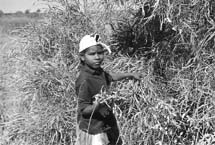
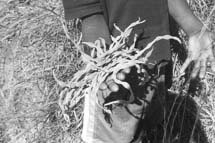
Ben Dickensen collecting
bush beans, wurtila. Photo: Alison Alder
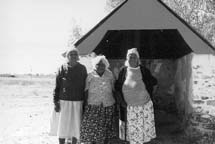
Eileen Nelson Nappanangka,
Dora Dawson Nangali and Kathleen Fitz Nappanangka outside the cookhouse
at the Telegraph Station. Photo Kimberly Christen
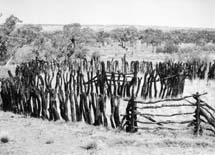 Cattleyard
in the Murchison Range. Photo D. Curtis Jungarayi.
Cattleyard
in the Murchison Range. Photo D. Curtis Jungarayi.
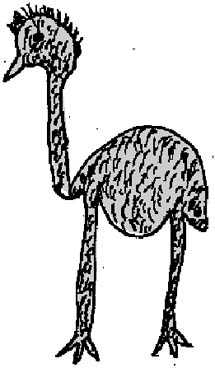
Emu, karnanganga.
Drawing by Nakkamarra
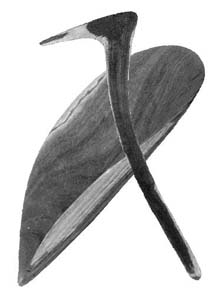

(above) Jimmy Frank Juppurrula and Archie Allen Jangali. Boomerang and
coolamon carved by Day Day Frank Jakkamarra.